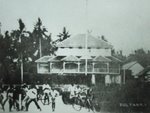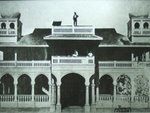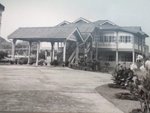In front of his beautiful rich wife, he was too ashamed to acknowledge her as his mother and threw her overboard. She was shocked and very depressed and placed a curse on her unfilial son whereupon a storm suddenly appeared capsizing the ship and transforming it into rock.
Another variation to the story was that he was well to do but went away just the same, to find out what the world can offer him. His mother in the meantime became poorer as she spent quite a large sum of money searching for her long lost son. But the result ended in the same way, he refused to acknowledge her and she cursed him in the end. Sounds familiar?
In Malaysia, this tale is known as the tale of Si Tanggang, in Indonesia as Malin Kundang and in Brunei as Nakhoda Manis. Each and every single country has natural proof of the legend. Malaysia has the Batu Caves in Selangor where the caverns of the caves are said to resemble the cabins of the ship. Indonesia has the pieces of the ship in rock forms including that of a rock which resembled a man prostrating for mercy along the beach in Air Manis, Sumbar about 20 kilometers from Padang in Sumatra. Brunei too has the Jong Batu, a small island which jutted out of the water in the Brunei River which resembled the keel of the ship jutting out. So, who is right?
Well, this article is not a scholarly attempt to find out whose story it is. But what is interesting is how the stories can be made to fit into each other regardless whether one is in Brunei or one is in Indonesia. The Brunei and Indonesian versions have natural rock formations which look fitting as well.
The Malaysian one is more interesting as the story was originally an Orang Asli’s story namely the Temuans who lived near the Batu Caves. Even in print form, the story first appeared in print form in a text book in the early 1960s, the story was that of an Orang Asli. However by the 1970s, the Tanggang story became an all-Malay story and has remained so until now. The Batu Caves was discovered by an Indian in the early 1800s and by the 1890s, Hindu devotees began making pilgrimages and slowly turning the caves into a huge shrine attracting some 1.5 million Hindus every year.
Similarly the Indonesian rock formation is easily visited as it is by the beach becoming a shrine or an attraction of some form. However the Brunei’s Jong Batu is fairly inaccessible. It is some distance away from the nearest residence being a small little island out in the waters of Sungai Damuan. Thus it is rarely visited as compared to the ones in Malaysia and Indonesia.

The few visitors who do manage to get there note the striking similarity of the keel of ships and that of the Jong Batu. What is interesting is how the same story albeit with slightly different variations has survived through the various countries and the various generations.
It begs the question whether we come from one origin and as our ancestors migrated, they carry with them the legend of the unfilial son. And whenever they stop and started a new community or settlement, they try to find the geographical formation that best fit the description of the legend.
Not surprisingly, even in Tutong, a similar legend was passed down through the generations. The only difference is that the name of the perpetrator is Si-Untak. The ship that was cursed by Si-Untak’s mother sank in the Tutong River and up to now, the rock formation known as Batu Ajung Si-Untak that resembled the ship is still there near a place called Telting in Pekan Tutong. Maybe it does matter to some, in the end, it does not really matter who owns the story - we don't even know our own origins.
In the mist of time, it is possible that all of us all come from the same stock and therefore share the same stories passed down through legends. But what is more important is the lesson that the legend offers. In our Asian society where filial piety – serving one’s parents and elders - is important - the unfilial son's great sin for being unfaithful to his mother was considered unnatural.
That great sin was punished with him and his ship being transformed into rock forms forever to serve as a reminder, a warning and a lesson to all of us. The fable served the most important lesson that we should never be unfaithful to our parents no matter what the situations are and that we should always remember the sacrifices that they made for us.
Note: An edited version of the above article was published in The Golden Legacy column in The Brunei Times dated 31st March 2007.












No comments:
Post a Comment